It's a great time to be a Red Planet researcher. Right now three orbiters and two rovers are checking out Earth's planetary neighbor from very close range.
Here's a question to stump your space-cadet friends: When were the greatest number of spacecraft operating at once on or around Mars?
The answer: 2007. That's when the Red Planet was being scrutinized by three orbiters (Mars Odyssey, Mars Express, Mars Reconnaissance Orbiter) and three landers (Spirit, Opportunity, and Phoenix). The total would have been seven, but contact was lost with NASA's Mars Global Surveyor about seven months before Phoenix arrived.
Five years later, we're still in the midst of a breathtaking period of Martian exploration. Ignore, for a moment, the loss of Russia's Phobos-Grunt craft in mid-January or NASA's apparently bleak prospects for funding Mars missions down the road. Those three long-lived orbiters are still going strong — and while the rover Spirit has been lost, its twin, Opportunity, continues to amaze its handlers. Meanwhile, Curiosity is just getting revved up for its two-year exploration inside Gale crater.
So here's a quick recap of where each of these missions stands:
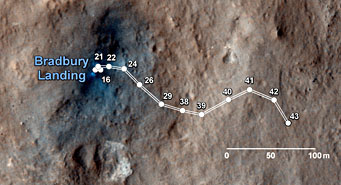
As of September 19, 2012, Curiosity's 43rd sol ("day") on Mars, the rover had traveled about halfway to its first major scientific objective: the confluence of three geologic terrains called Glenelg.
NASA / JPL / Univ. of Arizona
Curiosity, a.k.a. Mars Science Laboratory, has been making tracks since August 22nd, when it took its first tentative rolls away from its touchdown site, now called Bradbury Landing. So far it's covered about half of the 1,500 feet (450 m) to its first major objective, a confluence of three geologic terrains known as Glenelg. The ground is firm, and traction is good.
On September 13th, corresponding to its 37th sol (Martian day) on the surface, the rover used its Mast Camera to look skyward and capture transits of Phobos and Deimos, Mars's small moons, as they crossed the Sun's disk. The camera has a filter specifically included for viewing the Sun, which will provide measurements of the dustiness of the atmosphere.

This animation is part of a 256-image sequence taken on September 13, 2012, using the half of Curiosity's Mast Camera equipped with 100-mm-focal-length optics. Special filters allowed the camera to observe the Sun directly as the dark silhouette of the small Martian moon Phobos blocked about 5% of its disk.
NASA / JPL / MSSS
But timing of the moons' transits has a wholly different purpose. "Phobos is in an orbit very slowly getting closer to Mars, and Deimos is in an orbit very slowly getting farther from Mars," explains Mark Lemmon (Texas A&M
University). Careful timing of the events should reveal the planet's exact shape and, from that, information about its interior structure.
Right now the rover is analyzing a largish rock, about 10 inches (25 cm) tall and 16 inches (40 cm) wide, situated along its path. Named "Jake Matijevic," to honor a recently deceased JPL engineer who worked extensively on Martian rovers, the angular rock will get full-service treatment from Curiosity: the rover's arm-mounted Alpha Particle X-Ray Spectrometer will assess its elemental composition, as will the laser-wielding ChemCam instrument mounted on the central mast. However, the rover won't start grinding up surface samples for analysis until it reaches Glenelg, which will take another two weeks.
By the way, we're maintaining an online gallery showing recent images taken by Curiosity.
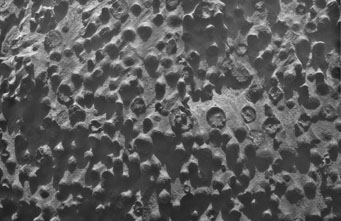
Small spherical objects fill this mosaic from Opportunity's Microscopic Imager. The view is about 2.4 inches (6 cm) across), and the individual spherules are up to 3 mm across. Click on the image for a larger version.
NASA / JPL / Cornell / USGS / Modesto Junior College
Opportunity, meanwhile, continues to poke around the edge of Cape York on the rim of Endeavour crater. Two weeks ago the rover reached a light-toned outcrop, dubbed Kirkwood. Mission geologists believe it to be enriched in clay minerals, presumably created long ago when surface rocks interacted with liquid water. Indeed, a picture beamed back earlier this month shows a collection of tiny spherules, no bigger than small peas, that bear a striking resemblance to the "blueberries" found weeks after Opportunity's arrival in 2004. But they're different.
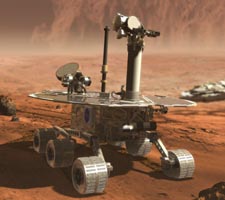
The rover Opportunity continues to operate well on Mars — despite having landed more than 8½ years ago. It carries a suite of five instruments, collectively called Athena, and an abrasion tool for exposing fresh surfaces on rock faces.
"This is one of the most extraordinary pictures from the whole mission," noted principal investigator Steve Squyres (Cornell) in NASA's September 14th press release. These little nuggets might likewise concretions that formed as mineral-laden water percolated inside Martian rocks. However, they lack the blueberries' high iron content and have a different consistency — which Squyres describes as "crunchy on the outside, and softer in the middle."
Generally, "Oppy" remains in good health and continues to operate normally despite having spent more than 3,000 sols on the Red Planet. As noted in the most recent mission update, the rover is keeping quite busy and, to date, has traveled 21.78 miles (35.05 km) across Merdiani Planum.
Of the three orbiters, Mars Odyssey has been there longest (since October 24, 2001). The spacecraft is starting to show its age: a spinning wheel used to maintain orientation seized up in early June. After a little angst, ground controllers successfully switched to a backup that hadn't been used since launch. This brought Odyssey back online in time to relay transmissions from Curiosity during its descent and touchdown.
Although officially named "2001 Mars Odyssey," a goofy nod to a certain classic sci-fi film, no one really uses that anymore. The spacecraft has only three instruments, the workhorse of which is THEMIS (Thermal Emission Imaging System). Its five visible-light and 10 infrared channels have mapped the distribution of specific minerals all around the Martian globe — maps that were key to picking Gale crater as Curiosity's landing site. But the camera also takes great images of the landscape below it, and you'll find new pictures posted every week at the THEMIS website.
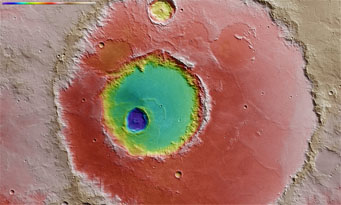
Researchers have used stereo images from the Mars Express orbiter to determine altitudes (shown here as color coding) inside Hadley crater on Mars. The floor of Hadley, 80 miles (120 km) across, has been punctured by two later impacts that are nested inside each other. The innermost one (dark blue) has a depth almost 1.6 miles (2.6 km) below the terrain surrounding Hadley.
ESA / DLR / FU Berlin / G. Neukum
Mars Express slipped into orbit around the planet on Christmas Day in 2003. Built and managed by the European Space Agency, this very capable spacecraft carries six instruments to study the Martian surface and atmosphere. It's probably the most successful interplanetary spacecraft that you've never heard of — or at least never hear about.
The main imager on Mars Express is its High Resolution Stereo Imager, which can record surface details as small as 7 feet (2 m). The HRSC team has used the camera's stereo capability to create some dramatic "you-are-there" vistas of the Martian landscape. Two other instruments are worth a mention here: the Planetary Fourier Spectrometer, which picked up traces of methane in the Martian atmosphere that remain perplexing to scientists, and the MARSIS radar altimeter, which has mapped deeply buried ice deposits and hidden craters.
Although ESA's orbiter also provided support during Curiosity's landing, it has since returned to studying the planet. Recently its instruments focused on Hadley crater, 80 miles (120 km) across, in which are two subsequent impacts that are inside one another. The result is a nested bull's-eye pattern that geologists can use to probe deeply into the martian crust. As detailed in an ESA press release, the crater shapes within Hadley show evidence of water or some other volatile buried in the floor.
Notably, Mars Express flew to the Red Planet accompanied by Beagle 2, a lander designed to look specifically for evidence of past or present life. But no one knows whether this novel lander reached the Martian surface intact — it failed to establish radio contact after its descent. (I recount more details of Beagle 2's failed mission a couple of months ago in "Martian Landings, Then and Now.")
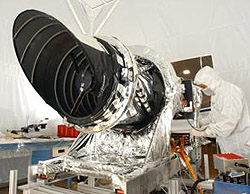
The HiRISE camera on NASA's Mars Reconnaissance Orbiter records the Red Planet's surface in unprecedented detail using a 20-inch (0.5-m) f/24 telescope.
NASA / JPL / Ball Aerospace
NASA's Mars Reconnaissance Orbiter, which arrived in March 2006, has redefined "close scrutiny" as it traces how the planet's history has been influenced by water. Its HiRISE camera, boasting the largest aperture ever carried to another world (full specs are here), can resolve surface features the size of a dinner plate. It has famously taken snapshots of Phoenix descending toward its touchdown and spied on Curiosity's landing site with almost unbelievable detail.
But mission support isn't MRO's main job. Instead, it has deluged planetary scientists with more than 177 terabytes of data about the Red Planet's geology, surface chemistry, atmospheric dynamics, and water inventory. One advantage of lasting so many years is that HiRISE can record the changing shapes of sand dunes or identify fresh impact craters soon after they form.
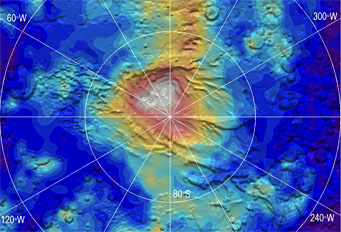
Observations by NASA's Mars Reconnaissance Orbiter have detected clouds of dry-ice "snow" over the Red Planet's south pole. Color coding shows the mean diameter of carbon-dioxide grains detected by MRO's Mars Climate Sounder, from 4 mm (gray) to 50 mm (dark blue). Click on the image for a larger version.
NASA / JPL / Caltech
MRO continues to examine Mars with its suite of six instruments. One recent result involves the Mars Climate Sounder, which uses nine visible and infrared bands to track the presence of particles and gases in the planet's atmosphere. In the Martian winter of 2006-07, the sounder recorded flakes of frozen carbon dioxide ("dry ice") in a large cloud suspended over the planet's south polar region. The thin Martian air needs to be colder than –193°F (–125°C) for CO2 gas to freeze, and this is the first unambiguous detection of dry-ice clouds. According to an analysis by Paul Hayne (then at Caltech) and others, published in Journal of Geophysical Research, the flakes were large enough that they likely were snowing onto the surface.
All three orbiters, plus Opportunity, have lasted far beyond their intended lifetime. If Curiosity continues this track record of success, we could be watching it trundle up and down the slopes of Aeolis Mons ("Mount Sharp") for many years to come.
 4
4
Comments
Jack Holt
September 24, 2012 at 1:37 pm
You didn't mention that MRO also has a radar sounder (SHARAD) which probes the subsurface. Among other things, SHARAD has enabled the discovery of mid-latitude glaciers under a thin cover of dust and rock, determined the polar caps are primarily made of water ice, found sequestered carbon dioxide ice within the south polar cap, and uncovered the origin of the spiral troughs in the northern polar cap.
You must be logged in to post a comment.
Robert
September 24, 2012 at 5:18 pm
We need a race to Mars. Create some international interest. How fast could we get there if we really tried. Two weeks? Nothing fancy has to land, just a remote controlled car with a camera. Better yet, a plant in a glass covered chamber, warmed at night, could be the first life on Mars. We know there is enough water for a colony on Mars. Tons of supplies have to be transported there, to the colony site, before we spend money to have the first humans arrive. Lets get going already!
You must be logged in to post a comment.
Anthony Barreiro
September 28, 2012 at 5:51 pm
Thanks Kelly for this great summary of what our two rovers and three orbiters are doing on and around Mars. P.S. to Robert -- I would much rather invest scarce resources into international projects to send scientific robots to the planets (as well as launching bigger and better space telescopes), instead of sinking all our money into a vanity project to put humans on Mars. The Space Race was so 1960's.
You must be logged in to post a comment.
Anko
October 3, 2012 at 12:24 pm
Very nice summary, brief but elaborate and clearly written with enthusiasm for the subject.
However, the last paragraph might be over-enthusiastic: Curiosity doesn't use solar power but a build-in power source. And that is designed to last for 1 Martian year, so just two years. That's hardly "many years".
Never the less, it would be interesting to see if also Curiosity will live up and above it's expectations!
You must be logged in to post a comment.
You must be logged in to post a comment.